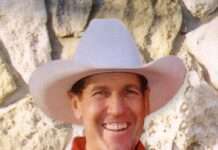“That horse is eating the barn down!”
Anybody who has handled very many horses has likely made that scary exclamation.
It is true that certain horses will chew and suck on anything wood whether stall, barn, hitching post, fencing, whatever. That’s called “cribbing,” and a horse who does it is called a “cribber.”
Without knowing the exact cause for cribbing behavior in horses, prevention is difficult, according to Sara Mastellar.
With an advanced degree in equine nutrition and behavior, Mastellar defined cribbing as a stereotypy or seemingly functionless repetitive behavior.
It is characterized by grabbing an upright object with the teeth and pulling with an arched neck and sucking air.
“Many horses exhibited wood chewing behavior before manifestation of cribbing,” said Mastellar.
Horses that crib may spend anywhere from 15 to 65 percent of their day cribbing.
Approximately 4 percent of horses in the country are cribbers with cribbing mentioned in literature as early as 1578. However, cribbing has not been reported in feral horses that are free ranging.
“It is possible that aspects of management may cause the cribbing behavior,” Mastellar said.
Specific causes of cribbing are yet to be determined and the behavior may be due to a combination of factors.
Diet, genetics, boredom, stress, and copying another horse have all been suggested as causes of cribbing.
Horses that have more grain in their diet have been shown to be at an increased risk of cribbing. Studies indicate that horses fed sweet feed have been known to crib more than horses fed oats.
In a horse owner survey, only 1 percent of horses developed a cribbing habit after exposure to another cribbing horse. It is unlikely horses learn cribbing behavior from one another.
Genetics could also play a role as Thoroughbreds and warmbloods are more likely to crib compared to other breeds. “A study found that cribbing is heritable and can be passed onto offspring,” Mastellar said.
Horses that crib will have increased wear on their incisor teeth but not cause problems for the horse until they are older. Additional teeth wear may ultimately shorten the life of the horse because they are not able to eat as effectively.
Moreover, cribbing horses may be harder keepers due to increased energy expenditure spending time cribbing instead of eating.
Horses that crib are at risk for colic and are more likely to have stomach ulcers.
“All of these issues contribute to the unpopularity of cribbing horses and a potential reduction in market value,” Mastellar said.
Reduced risk of cribbing is associated with increased time spent outside, and social contact with other horses. Keeping foals solely on grass through weaning might reduce cribbing.
“Once cribbing behavior is established, it is unlikely a horse will ever completely cease to exhibit the behavior,” Mastellar said.
Studies suggest that cribbing horses may have some physiological and mental differences or atypical hormone levels.
Horses that exhibit cribbing behavior may react to situations differently than their non-cribbing counterparts.
However, cribbing horses seem to have less anxious temperaments and are equally trainable when compared to non-cribbing horses.
The decision to inhibit a horse’s ability to crib should weigh the possibility of increasing stress against other health issues.
Many managers also consider the destructive nature of cribbing behavior on barns and fences.
“Cribbers are motivated to crib and will work hard for an opportunity to crib,” Mastellar said. “This motivation makes keeping an established cribber from engaging in cribbing behavior particularly difficult.”
The characteristic cribbing collar is the most commonly used method to prevent cribbing. “A collar can be effective preventing cribbing, but they are only effective when the horse is wearing it,” she said.
Horses that are allowed to crib after being prevented from cribbing will have an increased cribbing rate “It’s as if to make up for lost time,” Mastellar said.
“Cribbing rates increase after a concentrate meal. So formulating diets that contain more forage and less grain can help to mitigate cribbing behavior,” Mastellar said.
Horses fed many small concentrate meals may actually crib more because cribbing is associated with feeding time.
If there is a need to keep a cribber stabled, providing a toy has been shown to reduce cribbing rates slightly. Turnout, socialization, and prevention of boredom are all forms of stress reduction for these horses.
Additional possible ways to reduce cribbing include eliminating cribbing surfaces, taste deterrents, cribbing surface electrification, pharmaceuticals, oral antacids, and surgery.
Cribbing in horses is likely a permanent behavior pattern once established. The exact cause of cribbing in horses remains to be determined.
Therefore, consider not breeding to a horse that cribs. Provide plenty of forage. Allow horses turnout time. Encourage interaction with other horses,” Mastellar summarized.
CUTLINES
Cribbing is a repetitive behavior characterized by a horse grabbing an upright object with the teeth and pulling with an arched neck and sucking air.
With an advanced degree in equine behavior, Sara Mastellar defined cribbing as a stereotypy or seemingly functionless repetitive behavior in horses.




